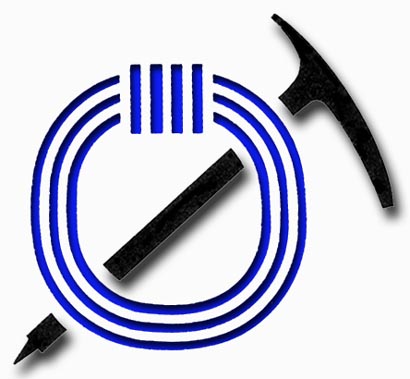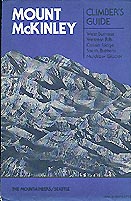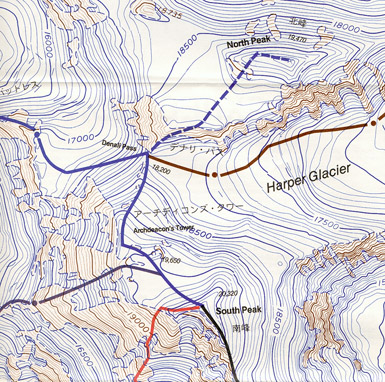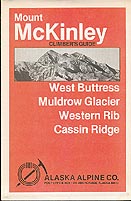
West Buttress
Westliche
Stützmauer
Le Contrefort
de l'Ouest
South Buttress
Südliche
Stützmauer
Le Contrefort
du Sud
Muldrow Glacier
Muldrow
Gletscher
Le Glacier
Muldrow
West Rib
Westliche Rippe
La Côte
de l'Ouest
Cassin Ridge
Cassin Kamm
La Crête Cassin
Coming Soon
Doug Scott &
Dougal Haston's
South Face Direct
This map and
the climbing
descriptions can
only serve as
general guides to the
five major routes on
Mt. McKinley because
of daily and seasonal
conditions.
On a big mountain,
no guide or map
can safely be
substituted
for good
mountaineering
judgement.
Copyright © 2001
by Dennis Cowals.
All rights reserved.
Ice axe and rope logo
copyright © 2001
by Dennis Cowals.
Mountaineers edition
copyright © 1981
by Dennis Cowals
ISBN 0-89886-020-2.
First edition
copyright © 1976
by the Alaska
Alpine Company.
Ken Bayne's
Mt. McKinley (Denali)
Climbing
Guide
Carl Ockier's
Climbing Dictionary


Denali National
Park & Preserve
Mountaineering Guidelines,
Regulations & Information
Mountaineering in
Denali National Park
& Preserve
ALASKA LINKS:

North to Alaska?
These friends
are good folks
to contact.
We've shared
many climbs,
rescues and
adventures
over the years.
EQUIPMENT:
Climbing equipment needed for an expedition to Mt. McKinley is basically the same as that needed for a high mountain ascent anywhere in the world, only with greater emphasis, perhaps, on items of clothing capable of keeping climbers warm and dry.
Polarguard sleeping bags, for example, have proven more effective when wet than down bags. Some climbers now use both types in combination, slipping a down bag inside a synthetic outer bag to increase insulation in wet conditions.
Pile garments have very much come into their own in recent years. Now, they're almost standard as part of the mountaineer's uniform. On McKinley, they have proven to be very practical, especially if worn under wind-proof shell parkas of nylon or Gore-Tex. Much lighter than the traditional heavy woolen sweaters, pile sweaters and zip-front jackets have proven themselves more versatile and much faster drying than wool.
Synthetic plastic and nylon double climbing boots are replacing traditional leather double boots; and they have proven adequate to McKinley's temperature demands. Insulated gaiters and overboots are still preferred by many climbers. But the warmest boot of all is still the U.S. Army surplus vapor barrier boot which was originally developed during the Korean War. They're available as Korean Boots or Mickey Mouse Boots, or as VB Boots at many surplus outlets. However, they are not well suited to McKinley's more technical routes. Import copies, unfortunately, have not been as durable or as warm as original U.S. Army surplus fabricated by American manufacturers.
More and more climbers are carrying 10-foot squares (3 meters by 3 meters) of heavy black plastic for use as solar stills to melt snow for drinking water. In June and July, when daytime temperatures soar, the black sheets can melt an entire party's water supply during the day while climbers are relaying loads. Their use helps conserve fuel which may be needed during a storm emergency higher on the mountain.
Children's plastic sleds, likewise, have been found to be of considerable value on long, relatively flat approach marches across glaciers or snowfields. It's easier to pull a load than to carry one. Using the bathtub-shaped sleds also makes it easier to remove equipment and trash from the mountain, a practice highly recommended by the National Park Service and environmental groups.
If fixed rope is used, three-eighth inch (9mm) polypropylene is usually satisfactory. However, on critical sections such as the Japanese Couloir, it is recommended that 8 or 9mm kernmantle rope be used for safety.

Mt. McKinley Summit 1:25,000 scale - adapted from U.S.G.S.
West Buttress Muldrow Glacier
West Rib Cassin Ridge South Buttress
|
PERSONAL EQUIPMENT boots,* or double boots with gaiters or overboots** climbing skins and poles, or 10 x 56-inch (25 x 140-cm) snowshoes with locking caribiners Petzl or Clog ascenders and foot slings** on the Muldrow approach) (wool, silk or nylon) and one pair of nylon shells rated to -40° F/C or large soft pack** medications, toothbrush & toiletries |
GROUP EQUIPMENT climbers,* or one 150-foot x 11mm climbing rope** of 3/8ths inch (9mm) polyproplyene rope. (Available locally in Anchorage from Alaska Industrial Hardware and others.) and utensils Five gallons (19 liters) is usually sufficient for a four-man party. or two-man tents with rainflys** - about 2 pounds (890 gm) per climber per day or 100 flagged willow wands** ski and snowshoe bindings, etc. ice axe and sun glasses playing cards, etc. * Recommended for West Buttress and Muldrow Glacier Routes. ** Recommended for West Rib, South Buttress and Cassin Ridge.  | |
|
All equipment needed for an expedition to Mt. McKinley is available in Anchorage, normally the starting place for most groups. No equipment is available at Denali National Park & Preserve. Climbers planning to obtain needed equipment in Alaska should contact suppliers in advance to make certain items are available. Two Talkeetna climbing shops now offer equipment sales and rentals, including sleds, white gas, CB radios, maps, photos, ice axes, snow saws, skis, snowshoes, overboots, snow pickets, wands, and a variety of last-minute items. Talkeetna Outdoor Center P.O. Box 748 Talkeetna, AK 99676 Phone and Fax: (907) 733-4444 Toll-Free: (800) 349-0064 Windy Corner Downtown Talkeetna Talkeetna, AK 99676 Phone: (907) 733-1600 | ||
